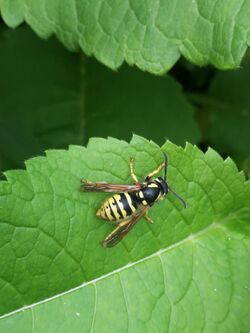Biology:Dolichovespula omissa
| Dolichovespula omissa | |
|---|---|

| |
| Dolichovespula omissa queen | |
| Scientific classification | |
| Domain: | Eukaryota |
| Kingdom: | Animalia |
| Phylum: | Arthropoda |
| Class: | Insecta |
| Order: | Hymenoptera |
| Family: | Vespidae |
| Genus: | Dolichovespula |
| Species: | D. omissa
|
| Binomial name | |
| Dolichovespula omissa Bischoff, 1931
| |
Dolichovespula omissa is a species of wasp in the family of Vespidae.[1] It lives as a social parasite by letting colonies of Dolichovespula sylvestris raise their young.
The wasps reach a body length of 15 to 18 millimeters (females) or 14 to 16 millimeters (males). Their yellow-black pattern is hardly variable. The males can only be distinguished from the other species of the genus Dolichovespula by details of the genital capsule.
Occurrence
The species occurs from the northern parts of southern Europe to southern Scandinavia and Turkey. It inhabits various open habitats, light forests, and forest margins. It is rare in Central Europe. It flies from mid-June to early September. Young animals of the new generation fly from mid-July onward.
Naming
In other languages common names exist for the species that highlight the social parasitism lifestyle by referencing the cuckoo, which is famous for this behaviour. The German name "Waldkuckuckswespe" and Dutch "Boskoekoekswesp" both translate to "forest cuckoo wasp". In Swedish "Skogssnyltgeting", and Norwegian "Skoggjøkveps" refer to similar concepts.
References
- ↑ Lopez-Osorio, Federico; Perrard, Adrien; Pickett, Kurt M.; Carpenter, James M.; Agnarsson, Ingi. "Phylogenetic tests reject Emery's rule in the evolution of social parasitism in yellowjackets and hornets (Hymenoptera: Vespidae, Vespinae)". Royal Society Open Science 2 (9): 150159. doi:10.1098/rsos.150159. PMID 26473041. PMC 4593675. https://royalsocietypublishing.org/doi/10.1098/rsos.150159.
Wikidata ☰ Q1233272 entry
 |

